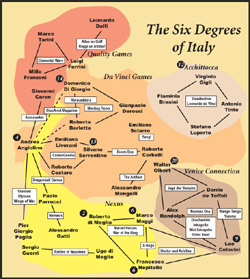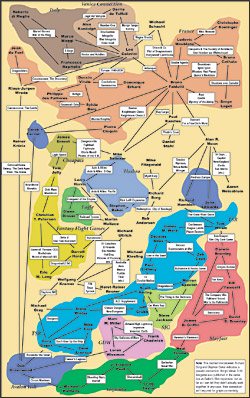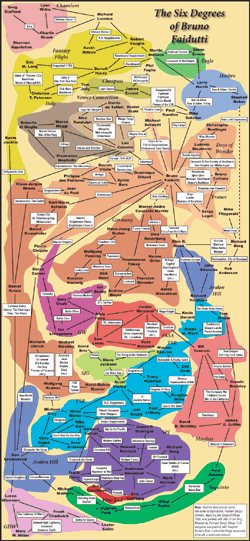 One of the Holy Grails of modern game design seems to be "Civ Light", a game that inexplicably is like Francis Tresham's 1980 masterpiece Civilization, yet at the same time is not. Every year lately one or two games come out that are proclaimed--by designers, fans, or both--to be this Grail, and every year each and every one fails to live up to the standard--potentially because it sets an impossible bar.
One of the Holy Grails of modern game design seems to be "Civ Light", a game that inexplicably is like Francis Tresham's 1980 masterpiece Civilization, yet at the same time is not. Every year lately one or two games come out that are proclaimed--by designers, fans, or both--to be this Grail, and every year each and every one fails to live up to the standard--potentially because it sets an impossible bar.In this article I want to look at first Civilization itself, then the many contenders for the "Civ Light" throne. In the process I'll give each game a "Civ Score", which is a 4-point score based on how well the game mimics the four core Civilization gameplay elements of civilization advance, resource management, trade, and warfare and measure the "Weight" of the game, based on BGG stats. Though both stats are clearly somewhat arbitrary, I think they offer relatively analytical measures of how each game approaches the Civ Light ideal.
Civilization (1980)
Author: Francis TreshamMajor Game Systems: Civilization Advance, Resource Management, Trade, Warfare
Score: 4.00/4 Civs :: 3.80/5 Weight
Comments: Like some of the best board games out there, Civilization is truly a creative endeavor. You feel like you're creating and expanding a civilization because it gains a unique character as you expand it in certain ways across the board and as you select certain civilization advances to build.
I think that the idea of "civilization advance" (or technology, if you prefer) is potentially the core of a civilization game and ultimately the aspect that pretty much no other game has ever duplicated. In Civilization players have numerous different advances they can build, each of which gives some advantage to their civilization, and many of which are built into "trees", where one advance is required in order to purchase another.
Other players consider the trade the most important element of gameplay, and it is a well-developed system in Civilization. There is warfare, and you do have to be careful about how you collect (and use) resources, but the simple idea of trading in order to collect sets of increasing value can make or break your game (and likewise adds another element that many Civ Light games don't have).
It's probably been at least 10 years since I've played Civilization and that falls to its main flaw: game length. Civilization can easily be a full day event running at 12 hours, plus or minus, and in an era where a 2-4 hour game is stretching it, Civilization is pretty much never going to hit the table, hence the desire for "light" variants, by which most people mean: a faster, more elegant version of Civilization that nonetheless has all the core attributes.
Vinci (1999)
Author: Philippe KeyaertsMajor Game Systems: Civilization Advance, Resource Management, Warfare
Score: 1.50/4 Civs :: 2.88/5 Weight
Comments: I don't know that anyone actually ever called Vinci Civ Light, but it wouldn't surprise me. It's a game where you're trying to build up Civilizations in Europe by taking advantage of unique technologies and are trying to gain controls of specific territories whose resources advantage you.
However, the "Civilization Advance" feature is relatively vestigial. Each civilization has its own pair of advantages, and there's no way to improve or build upon them. Likewise, the resource management is solely a player-specific conduit to victory points. The only fully developed Civ system is warfare, and by its core importance, the game is actually distanced quite a bit from Civ proper, which included warfare as an option, not a necessity.
Overall, not a Civ Light game at all, but a wargame that does include the interesting facade of some of the same ideas.
Mare Nostrum (2003)
Author: Serge LagetMajor Game Systems: Civilization Advance, Resource Management, Trade, Warfare
Score: 3.00/4 Civs :: 2.99/5 Weight
I'm surprised this game didn't get more attention as a Civ Light game, though maybe it did back in 2003. In summary, it's got all of the elements, and it was purposefully (and well) designed to fit the niche.
Resource management and trade are both precisely in the Civilization mode, with your collecting typed resources and then trading those to get the right sets to build what you want. Likewise there's a solid combat system that nonetheless isn't exactly the point of the game: you can win without it, but you'll probably have to face it at some time.
Mare Nostrum's biggest failure in the Civ Light contest, and perhaps what knocks it from the competition entirely, is its lack of any sort of meaningful technology. There are Wonders of the World, and they're crucial to the game, but each is unique, and there is no tree, so these just aren't built or used in the same way as technology would be.
Also, the game length is a bit long, trending toward the 3 hour range, when most of these others can eke by at 2. And, I have one game design complaint, which is the ending can be very sudden. But, these are minor in the face of how well Mare Nostrum otherwise pulls off this style of gameplay.
Overall I'd consider Mare Nostrum the current winner of the Civ Light crown, with the major caveat that you have to not consider technology crucial.
Parthenon: Rise of the Aegean (2005)
Author: Andrew Parks, Jason HawkinsMajor Game Systems: Civilization Advance, Resource Management, Trade
Review: RPGnet (B)
Score: 2.00/4 Civs :: 3.06/5 Weight
Comments: In many ways, this isn't a bad adaptation of the most important aspects of a Civilization game.
The trade is best, because it's a complex system that allows trade with both other players and to the game system. Better, the system is set up to make trades mutually advantageous. The resource management pretty closely ties in to that because each player can produce certain resources and has to figure out ways to get the rest.
The biggest failing of Parthenon as a Civ Light game is ultimately in its limited scope--and this may well be an issue that ever contender for the Civ Light crown will face. There are very limited numbers of resources and limited ways to generate there and overall a limited scope for expansion. Technology isn't really built into a tree, and every player is trying to gain the exact same levels of tech, with the only difference being who does what first. You have no way of deciding that you want to head off in a certain direction because you're constrained by what you're allowed to build. Mind you, this all contributes to the tightness of the game, which is what makes it work, but it also keeps it away from being a true Civ Light game.
Likewise, the lack of a a true game board is likely to make anyone looking for a true Civilization game to turn away, and as noted in the overview above, there's no actual warfare either.
On the whole this is only a tiny bit closer to the Civilization ideal than Vinci. It turns out to not be a Civ Light game at all either, but instead a resource management game with a facade of Civilization.
Antike (2005)
Author: Mac GerdtsMajor Game Systems: Civilization Advance, Resource Management, Warfare
Review: GG Top Ten, Mini-Review (C+)
Score: 2.75/4 Civs :: 3.08/5 Weight
Comments: I really wasn't too enthused about this game after two plays, but in weighing it on the Civ Light barometer, I begin to understand better where other peoples' enthusiasm comes from. This game entirely neglects trade, but for the other three aspects of Civilization, it hits almost entirely dead on.
The Resource Management is a core part of the game, and it's both very different from Civilization and well-considered. There are only 8 technological advances, but there is a tiny bit of a tree (with each branch having two nodes), and unlike Parthenon there's no guarantee that everyone is going to hit all the levels. I find the combat somewhat troublesome because it feels too costly and too weighted toward the defender, but that's ultimately an issue of game design.
And it's in game design generally that Antike let me down. Besides not liking the combat dynamics I also feel like the victory points are set up in such a way that the entire game can bog down in some situations. Overall the game's just got too many sharp corners for me.
On the whole I'd say that Antike is a pretty good Civ Light design, minus the trading, but it's a pure indie design with enough awkward play and sharp edges that it'll always have somewhat limited appeal.
Tempus (2006)
Author: Martin WallaceMajor Game Systems: Resource Management, Warfare
Score: 1.50/4 Civs :: 3.24/5 Weight
Comments: Tempus has been long-hyped as Civ Light and is now facing some backlash, and I think it's pretty easy to see why when you measure it up as a Civilization style game.
Tempus gets the weight of warfare about right: it's important, but not central to the game. And that's about where it leaves Civilization land behind. There is a sort of resource management, but it largely centers on board position, and which lands you control and with which pieces at any time--a pretty far stretch from the handheld resources of the most Civilization like games. (There are cards but they're just random special-power cards that you can buy.) There's likewise (and not surprisingly) zero trade.
However, where Tempus falls down (as a Civ Light game), and where it's most likely to disappoint, is on the question of technology. In short: there isn't any. There's a theoretical "technology track", but all players advance along it simultaneously, and at best any player might be one space ahead on any turn. It thus ends up being just another resource to manage.
Don't get me wrong. Tempus is a very clever game that I'm quite happy to play. Its style of resource management, and the strategy that it entails, is quite clever. However, though it has the facade of a Civ Light game, like Vinci and Parthenon it's really a totally different sort of game.
Conclusion
In chart form, here's my rundown of the Civilization-like games, from most to least:| Game | Civ. Score | Notes |
| Civilization | 4.00/4 | Way too long for a "light" game. |
| Mare Nostrum | 3.00/4 | Largely misses Technology. A bit longer than others. |
| Antike | 2.75/4 | No Trade. Technology a little light. Some developmental issues. |
| Parthenon | 2.00/4 | No board. No Warfare. Technology is light & ubiquitous. |
| Vinci | 1.50/4 | A wargame with Civilization facade. |
| Tempus | 1.50/4 | A resource game with Civilization facade. |
On the whole, this analysis tells me a few different things.
First, not a single game has passed the 75% level for trueness to Civilization gameplay in a Light format. Mare Nostrum is the closest by hitting 3 out of 4 elements almost dead on, but it's near total ignorance of technology just about knocks it out of contention. Antike is next, but various systems come up short, and I also don't particularly like the development work.
I'll add and clarify that I'm measuring these games based on similarity to Civilization. I think they're all good or better games, with Antike slightly trailing the pack.
Second, I found this analysis interesting for where it shows Civilization-light games being created: 2 French designs, 1 English design, 1 American design, and 1 German design. The Civ Light games are coming from all over, but clearly more from countries with a strong Anglo-American influence (which makes me wonder if we'll soon see Civ Light games from Italy as well).
Third, I increasingly wonder if a Civ Light game might be a mirage. The core element of Civilization as I said, is the joy of creating this unique, expansive civilization. I'm not entirely sure if this can be done in a short game, and looking at how limited the technologies are in every one of these games just increases my belief.
On the other hand, writing this article makes me want to go try my own game design skills at the problem ... which makes me believe that we'll keep seeing entrants in this genre for years, whether the goal be a will o' the wisp or not.







